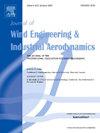Two parallel cable trusses-supported photovoltaic system: Extreme wind-induced response and displacement-based gust response factors
IF 4.9
2区 工程技术
Q1 ENGINEERING, CIVIL
Journal of Wind Engineering and Industrial Aerodynamics
Pub Date : 2025-07-07
DOI:10.1016/j.jweia.2025.106157
引用次数: 0
Abstract
With the growth of the solar photovoltaic industry, cable-supported photovoltaic structures (CSPSs) have become a research focus. Gust response factor (GRF) quantifies the amplification of dynamic responses relative to mean wind responses and is crucial for designing. However, unified standards for determining the peak factor are absent, and GRFs vary widely across structural forms, necessitating focused studies on different CSPS types. This study investigates the wind-induced vibrations and GRFs of the two parallel cable trusses-supported photovoltaic systems, using tilt angle, turbulence intensity, and wind speed as variables. Displacement responses were examined by aeroelastic model tests in the wind fields with varying turbulence intensities, focusing on Gaussian or non-Gaussian properties. Peak factors were derived using the piecewise Hermite polynomial model to calculate extreme responses and GRFs. Analyses reveal that buffeting-dominated responses exhibit Gaussian characteristics, with skewness near 0, kurtosis near 3, and a peak factor around 3.9, while self-excited vibrations exhibit hardening non-Gaussian properties, with kurtosis around 1.5 and a peak factor below 2.5. Turbulence intensity, with a feature importance exceeding 0.8, is the dominant factor affecting GRFs. Empirical models incorporating turbulence intensity, wind speed, and tilt angle align well with experimental data, demonstrating engineering applicability.
两个平行缆索桁架支撑的光伏系统:极端风致响应和基于位移的阵风响应因子
随着太阳能光伏产业的发展,索撑式光伏结构已成为研究热点。阵风响应因子(GRF)量化了相对于平均风响应的动力响应放大,是设计的关键。然而,目前还没有确定峰值因子的统一标准,而且不同结构形式的GRFs差异很大,因此需要对不同类型的CSPS进行重点研究。本研究以倾斜角度、湍流强度和风速为变量,研究了两个平行索桁架光伏系统的风致振动和GRFs。在不同湍流强度的风场中,通过气动弹性模型试验研究了位移响应,重点研究了高斯和非高斯特性。采用分段Hermite多项式模型推导峰值因子,计算极端响应和grf。分析表明,抖振主导的响应表现出高斯特性,偏度接近0,峰度接近3,峰值因子约为3.9,而自激振动表现出硬化的非高斯特性,峰度约为1.5,峰值因子低于2.5。湍流强度是影响GRFs的主导因子,特征重要性超过0.8。结合湍流强度、风速和倾斜角的经验模型与实验数据吻合良好,具有工程适用性。
本文章由计算机程序翻译,如有差异,请以英文原文为准。
求助全文
约1分钟内获得全文
求助全文
来源期刊
CiteScore
8.90
自引率
22.90%
发文量
306
审稿时长
4.4 months
期刊介绍:
The objective of the journal is to provide a means for the publication and interchange of information, on an international basis, on all those aspects of wind engineering that are included in the activities of the International Association for Wind Engineering http://www.iawe.org/. These are: social and economic impact of wind effects; wind characteristics and structure, local wind environments, wind loads and structural response, diffusion, pollutant dispersion and matter transport, wind effects on building heat loss and ventilation, wind effects on transport systems, aerodynamic aspects of wind energy generation, and codification of wind effects.
Papers on these subjects describing full-scale measurements, wind-tunnel simulation studies, computational or theoretical methods are published, as well as papers dealing with the development of techniques and apparatus for wind engineering experiments.

 求助内容:
求助内容: 应助结果提醒方式:
应助结果提醒方式:


